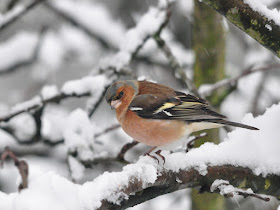The recent cold weather didn't result in any significant increase in birds visiting my garden and perhaps that is because we didn't get much snow in this area. Siskin, Long-tailed Tit and Starling actually visited less frequently and in smaller numbers than they had before the onset of the cold weather, which was a bit of a surprise. The smaller numbers of Siskin and Long-tailed Tit was mirrored by a dip in the BirdTrack reporting rate so it wasn't just a local phenomena as far as those species were concerned. On the other hand, the reporting rate for Starling increased on BirdTrack so my garden bucked the trend in that case. Garden birds just didn't seem to be pushed for food in this neck of the woods and the only unusual visitor I had in the garden was a Black-headed Gull that dropped in and took some bread from the lawn. It was a one legged individual and would have found feeding more difficult at the best of times so the fact that it risked landing in a small enclosed garden, crossed by telephone lines, during a severe cold spell is not as surprising as it otherwise might have been.
I have seen some effects of the cold weather when out an about including a few Woodcock in unexpected places, a sizeable flock of Redwing foraging in a woodland and a few displaced Meadow Pipits, but that is about it for me. Several checks of the Black-headed Gulls on Orrell Water Park have only produced one ringed bird that I have not encountered before and that bird was ringed as an adult near Hempsted in Gloucestershire on 13th January 2007. The Scottish and 2 German ringed Black-headed Gulls have been seen from time to time and all 4 ringed Black-headed Gulls were photographed yesterday along with a ringed Coot that was originally ringed in south Wales.
 |
| EL71428 first photographed on 28/02/2018 and again yesterday. |
 |
| It rarely kept still so I had to take quite a few photographs before I managed to get the full ring number - EL71428 |
 |
| Scottish ringed Black-headed Gull EZ33149 has been a regular this winter. |
 |
| German ringed Black-headed Gull DEH IA141745 almost has a full brown hood now. |
 |
| German ringed Black-headed Gull DEW 5437612 has barely started to get its brown hood. |
 |
| Coot GR03863 was originally ringed at Comeston Lakes, near Penarth, Vale of Glamorgan on 23/12/2010 and has been recorded at Orrell Water Park on numerous occasions since. |





































